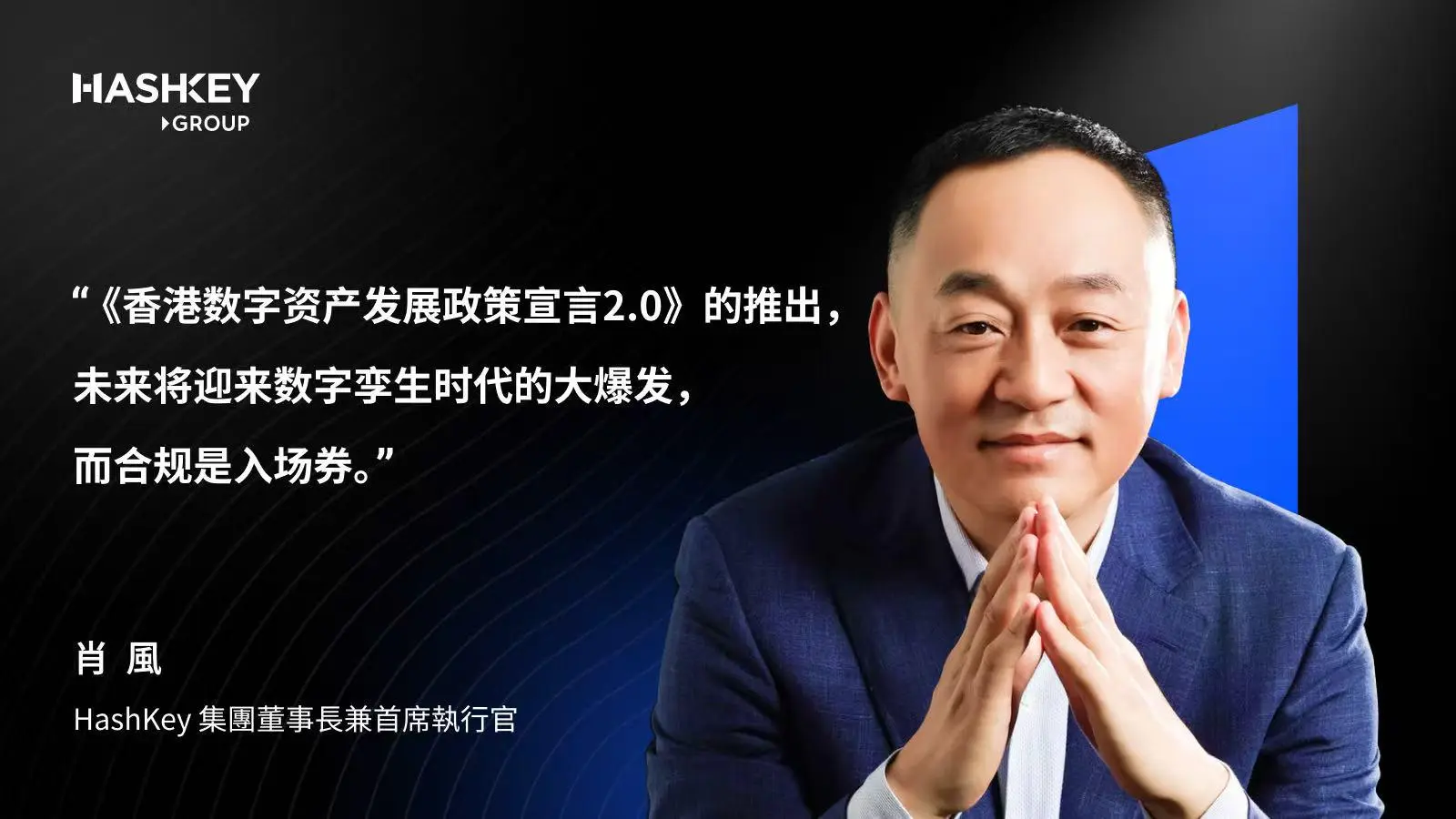Author: Nancy, PANews
On June 26, the Hong Kong SAR government published the "Hong Kong Digital Asset Development Policy Declaration 2.0," reaffirming its commitment to making Hong Kong a global innovation center in the digital asset field. The declaration proposes four major strategic frameworks under the "LEAP" initiative: optimizing laws and regulations, expanding the variety of tokenized products, promoting application scenarios, and fostering cross-sector collaboration.
To gain deeper insights into the profound impact of this policy change on Hong Kong, PANews interviewed Dr. Xiao Feng, Chairman and CEO of HashKey Group. In the interview, Dr. Xiao shared his unique perspective on the "Policy Declaration 2.0," believing that this policy marks a critical step for Hong Kong in transitioning from a digital asset "testing ground" to a global development hub, evolving towards "institutionalization, scaling, and globalization," where compliance will be the ticket to entry. Dr. Xiao further elaborated on how HashKey will deepen its strategic layout in areas such as stablecoins, RWA, and compliance platform construction under the policy's impetus, helping Hong Kong become a global digital asset hub.

Q1: How do you understand the "Hong Kong Digital Asset Development Policy Declaration 2.0"? What are the significant differences from the 2022 version?
Xiao Feng: The "Policy Declaration 2.0" is not a simple continuation but a systemic upgrade. It systematically promotes compliance regulation, asset tokenization, scenario expansion, and talent development around the "LEAP" strategic framework. This signifies that Hong Kong is not just a "testing ground" for digital assets but is beginning to evolve towards "institutionalization, scaling, and globalization."
The key changes are particularly evident in three areas:
Stablecoins will be regulated: A stablecoin licensing system will officially be implemented on August 1, 2025, making Hong Kong one of the few jurisdictions globally to provide a "landing pass" for stablecoins;
RWA tokenization is regarded as a key industry: The government is not only promoting the normalization of bond issuance but also plans to include tokenization of gold, green energy, electric vehicle assets, etc.;
Tokenized ETFs and digital asset funds will enjoy tax exemptions: If future legislation passes, tokenized ETFs will enjoy the same stamp duty exemption and profits tax exemption as traditional ETFs, rewriting the rules of the financial market.
These reforms send a clear signal: Hong Kong is not just supporting Web3 but aims to institutionalize Web3 as part of the financial infrastructure.
On the regulatory policy front, the update of Hong Kong's Web3 policy has completed a "trinity" of institutional closure:
Regulatory certainty: Hong Kong will become the first jurisdiction globally to clearly license independent digital asset custody services;
Asset penetrability: Allowing real-world assets (metals, energy) to be tokenized equally with financial instruments (bonds, ETFs), breaking the boundary between virtual and real;
Tax competitiveness: Tokenized ETFs are tax-exempt + profits tax exemption for digital asset funds.
This marks Hong Kong's official upgrade from a_ "regulatory testing ground" to a "global issuance and circulation hub for RWA (Real World Assets)".
Q2: Why have stablecoins become a policy focus? How will HashKey participate in this trend?
Xiao Feng: Stablecoins are evolving from "tool-based currency" to "infrastructure currency." Recently, the U.S. Treasury Secretary mentioned during the Senate's stablecoin bill passage that by 2030, there will be $3.7 trillion to $3.9 trillion in stablecoins circulating globally, representing a market that surpasses the financial scale of most countries.
Hong Kong's institutional design is clear, setting rules for stablecoin issuers regarding legal reserve management, redemption mechanisms, and risk prudence requirements. This transforms stablecoins from being a "club agreement" among tech people to a currency that can be accepted by banks, cross-border settlement systems, and the public sector, possessing both legal and technical attributes.
HashKey will deeply participate in three areas in the future:
• Supporting the launch of globally compliant stablecoins on the HashKey exchange, enhancing payment efficiency for cross-border e-commerce and global users;
• Piloting on-chain stablecoin settlement through a compliant platform, optimizing the clearing mechanism between OTC and exchanges;
• Participating in the design of mapping combination products for stablecoins and RWA, such as anchoring bonds, money market funds, etc., with stablecoins to build on-chain interest rate products.
Q3: RWA is another highlight of the policy; what profound impacts will this bring?
Xiao Feng: RWA is a channel for digital assets to support the real economy. The "Declaration 2.0" not only promotes the normalization of government tokenized bond issuance but also plans to include precious metals, green energy, warehousing logistics, etc., in the tokenization scope. This is not merely symbolic support but a pilot reform at the asset level.
More critically—
• The government will grant stamp duty exemptions for tokenized ETFs;
• The Monetary Authority will promote interbank tokenized deposit settlements through the Ensemble platform;
• Cyberport will work with regulatory agencies to advance digital asset regulatory technology and compliance sandboxes.
These all indicate one thing: Hong Kong aims not only to develop Web3 but to truly integrate Web3 with traditional finance.
As a compliant platform, HashKey will actively participate by:
• Continuing to build RWA on-chain infrastructure through HashKey Chain;
• Exploring secondary market trading mechanisms for compliant RWA;
• Collaborating with traditional financial institutions to create a new financial scenario of "bonds + tokens + settlement."
Q4: What impact will the new policy have on Crypto Natives?
Xiao Feng: The industry used to be two extremes: on one side, completely on-chain digital native assets like BTC and ETH, and on the other, entirely traditional systems. However, now, the emergence of stablecoins and RWA has bridged the gap between the two, which is the concept of "digital twins." Its essence is the on-chain mapping of real-world assets, representing asset-level Web3. For example, rights to green electricity, warehouse receipts for cars, government bonds, gold… all measurable and owned data can become on-chain tradable assets. The underlying logic is that we are transitioning from a "multi-chain prosperity" phase to a "main chain dominance" phase, no longer pursuing a quantity-based competition among hundreds of chains but returning to a competition based on the quality of infrastructure. Those who can support RWA and compliance mechanisms will prevail. The introduction of the new policy further confirms our observations of the Web3 industry; we are on the brink of a massive explosion in the era of digital twins, and compliance is the ticket to entry.
Q5: The policy also mentions international collaboration, tax system optimization, and talent strategy; what long-term impacts will this have on the industry?
Xiao Feng: These policies may seem peripheral, but they are actually building a moat for a financial-grade ecosystem:
• International cooperation: Hong Kong will collaborate with organizations like OECD and IOSCO to establish a cross-border regulatory framework, promoting mutual recognition of compliance;
• Tax incentives: Digital asset funds and family offices investing in tokenized assets will enjoy profits tax exemptions;
• Talent cultivation: The government will include Web3, AI, and blockchain in the key talent list, guiding universities and startups to jointly establish a "Web3 talent channel."
These are not short-term stimuli but mechanisms to anchor certainty, allowing international capital, talent, and technology to invest in the Hong Kong market long-term.
Q6: Under such policy dividends, how does HashKey position itself?
Xiao Feng: Our positioning is to provide trustworthy digital asset services to global users, aiming to become a bridge connecting traditional finance and the digital economy, promoting the popularization of digital assets and the arrival of the Web3 new era. We will not follow the old path of "competing for tokens on exchanges" but will establish a system of high liquidity + low slippage + compliant licenses, making it attractive for institutions and pragmatic users to come, stay, and thrive. We will also become one of the most important partners for many virtual asset exchanges in terms of inflow and outflow, providing highly competitive fiat channel services in multiple markets. In the face of institutional dividends, we will continue to build a new generation of financial infrastructure in Hong Kong and actively participate in Web3 policy discussions.
免责声明:本文章仅代表作者个人观点,不代表本平台的立场和观点。本文章仅供信息分享,不构成对任何人的任何投资建议。用户与作者之间的任何争议,与本平台无关。如网页中刊载的文章或图片涉及侵权,请提供相关的权利证明和身份证明发送邮件到support@aicoin.com,本平台相关工作人员将会进行核查。



